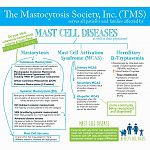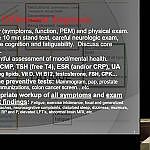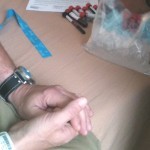The UK government has, after numerous delays, finally published its care plan for people with ME which afflicts over 400,000 people. Part of the plan includes increased funding for research, awarded through the National Institute for Health and Care Research, into how existing medicines can be used for ME. This aims to give pwME access to a wider range of potential treatments through sanctioning repurposed drugs for the treatment of our illness. One of the drugs which will be evaluated is low dose Naltrexone for which a substantial body of evidence has accumulated for its use to treat pwME.
Dr Etianne Sasso of Griffith University, Australia is part of team which has been conducting clinical trials into the use of LDN for treating pwME. She took time out of her busy schedule to talk about this research.
Dr Etianne Martini Sasso is a Research Fellow at the National Centre for Neuroimmunology and Emerging Diseases (NCNED), Griffith University, and her research focuses on the involvement of Transient Receptor Potential (TRP) ion channels in the pathomechanism of Myalgic Encephalomyelitis/Chronic Fatigue Syndrome (ME/CFS), long COVID, and Gulf War Illness, including pharmacotherapeutic interventions to improve symptoms and patients’ quality of life. She has multidisciplinary expertise in immunology, electrophysiology, pathology laboratory sciences (including biochemistry, haematology, immunology, urinalysis, and microbiology), and public health. She completed her PhD in early 2025 at the NCNED and School of Pharmacy and Medical Sciences, Griffith University, holds a Master of Medicine (Research), and a Bachelor of Medical Laboratory Science.
How did you get involved in the field of ME research?
ES: I was looking for an opportunity to return to the research field when I came across long COVID and noticed its significant overlap in symptoms with myalgic encephalomyelitis/chronic fatigue syndrome (ME/CFS). At that time, I had never even heard of ME/CFS. I was surprised that such a debilitating and impactful condition had never once been mentioned during my academic training or professional experience in health.
Curious to learn more, I began searching for information and came across a video featuring people living with ME/CFS. They shared how they had once led active, fulfilling lives but were suddenly burdened with a wide range of unexplained and persistent symptoms. I remember thinking: this could happen to me, or to someone I love, and how devastating it must be to experience such a life-altering illness without any answers or support.
In the same video, I saw Professor Sonya Marshall-Gradisnik discussing the research being conducted at the National Centre for Neuroimmunology and Emerging Diseases (NCNED) to help people with ME/CFS. I immediately felt a strong connection to their mission. I knew I wanted to be part of that team, contributing to science that could bring recognition, answers, and ultimately hope to people living with ME/CFS and long COVID.
TRPM3 & ME/CFS Relevance
Given the known immune dysfunction (especially impaired Natural killer cell function) in ME/CFS, did your team specifically look for or observe similar TRPM3 channel defects in NK cells from ME/CFS patients? If not, are there plans to investigate this? Why is TRPM3 function particularly important in the context of ME/CFS pathology?
Dr Etianne Sasso of Griffith University, Australia is part of team which has been conducting clinical trials into the use of LDN for treating pwME. She took time out of her busy schedule to talk about this research.
Dr Etianne Martini Sasso is a Research Fellow at the National Centre for Neuroimmunology and Emerging Diseases (NCNED), Griffith University, and her research focuses on the involvement of Transient Receptor Potential (TRP) ion channels in the pathomechanism of Myalgic Encephalomyelitis/Chronic Fatigue Syndrome (ME/CFS), long COVID, and Gulf War Illness, including pharmacotherapeutic interventions to improve symptoms and patients’ quality of life. She has multidisciplinary expertise in immunology, electrophysiology, pathology laboratory sciences (including biochemistry, haematology, immunology, urinalysis, and microbiology), and public health. She completed her PhD in early 2025 at the NCNED and School of Pharmacy and Medical Sciences, Griffith University, holds a Master of Medicine (Research), and a Bachelor of Medical Laboratory Science.
How did you get involved in the field of ME research?
ES: I was looking for an opportunity to return to the research field when I came across long COVID and noticed its significant overlap in symptoms with myalgic encephalomyelitis/chronic fatigue syndrome (ME/CFS). At that time, I had never even heard of ME/CFS. I was surprised that such a debilitating and impactful condition had never once been mentioned during my academic training or professional experience in health.
Curious to learn more, I began searching for information and came across a video featuring people living with ME/CFS. They shared how they had once led active, fulfilling lives but were suddenly burdened with a wide range of unexplained and persistent symptoms. I remember thinking: this could happen to me, or to someone I love, and how devastating it must be to experience such a life-altering illness without any answers or support.
In the same video, I saw Professor Sonya Marshall-Gradisnik discussing the research being conducted at the National Centre for Neuroimmunology and Emerging Diseases (NCNED) to help people with ME/CFS. I immediately felt a strong connection to their mission. I knew I wanted to be part of that team, contributing to science that could bring recognition, answers, and ultimately hope to people living with ME/CFS and long COVID.
TRPM3 & ME/CFS Relevance
Given the known immune dysfunction (especially impaired Natural killer cell function) in ME/CFS, did your team specifically look for or observe similar TRPM3 channel defects in NK cells from ME/CFS patients? If not, are there plans to investigate this? Why is TRPM3 function particularly important in the context of ME/CFS pathology?
(Imagine TRPM3 as a tiny "gate" on the surface of cells. This gate specialises in allowing calcium ions (charged particles) to flow into the cell when triggered. Calcium acts like a messenger, telling the cell to perform specific tasks)
ES: NCNED has previously investigated the TRPM3 ion channel in NK cells from ME/CFS patients. In 2018, the loss of TRPM3 ion channel function was identified for the first time in ME/CFS by the NCNED team (Cabanas et al., 2018). Subsequent studies revealed the potential of Naltrexone (NTX) to restore TRPM3 function in vitro (Cabanas et al., 2019; Eaton-Fitch et al., 2022), and further restoration was confirmed in NK cells from people with ME/CFS taking LDN (Cabanas et al., 2021).
When I began my PhD at NCNED, my goal was to explore the overlap between long COVID and ME/CFS. I compared TRPM3 function in ME/CFS, long COVID, and healthy individuals, and found no difference in TRPM3 impairment between ME/CFS and long COVID patients (Sasso et al., 2022). I validated this finding in additional cohorts, and it is now a consistent result. Given the similarity in TRPM3 dysfunction, I investigated in vitro Naltrexone treatment (Sasso et al., 2024). This was followed by our latest paper (the paper you have contacted us about), which confirmed that LDN also restored TRPM3 function in NK cells from people with long COVID.
Hence, TRPM3 dysfunction is similar in ME/CFS and long COVID, and LDN presents as a potential therapeutic option for both conditions.
Mechanism of LDN Action:
Your study shows LDN restores TRPM3 function. What is the proposed biological mechanism by which such a low dose of Naltrexone repairs this specific ion channel? Does it involve opioid receptors, glial cell modulation, anti-inflammatory pathways, or something entirely different related to ion channel regulation?
ES: Opioid receptors suppress the activity of TRPM3 ion channels and NTX is a drug that blocks opioid receptors. By blocking opioid receptor, NTX removes the inhibition opioid receptors have on TRPM3 and allows TRPM3 channels to function again. This effect is linked to a group of signalling molecules called G-protein-coupled receptors (GPCRs). When GPCRs are active, a sub unit of them can directly inhibit TRPM3. NTX works by stopping this chain of events, helping to restore TRPM3 function.
Beyond NK Cells & Calcium:
TRPM3 channels are found on many cell types beyond NK cells, including neurons, glia, and other immune cells. Dysfunction in these cells is implicated in ME/CFS symptoms (pain, fatigue, neuroinflammation). Did your research investigate whether LDN also restores TRPM3 function in these other relevant cell types from patients? If not, is this a future direction?
ES: The symptoms of ME/CFS are linked to tissues and organs where TRPM3 is already known to be expressed. However, studying these tissues can be challenging because most require a biopsy, which is a more invasive procedure that is sometimes not feasible or ethically allowed, such as in the case of obtaining cells from the central nervous system (CNS). NK cells have been used as a model instead, due to consistent evidence of immune dysfunction and reduced NK cell activity in ME/CFS. NK cells are also easily accessible from blood samples, requiring only a simple venipuncture. Another potential approach would be to study postmortem tissue, but this is limited by the difficulty in obtaining tissue donations.
Clinical Translation & Trials:
While the lab results are promising, what are the critical next steps needed to translate this finding into proven clinical benefits for Long COVID and ME/CFS patients? Are there specific plans for controlled clinical trials measuring symptom improvement alongside TRPM3/NK cell function in patients taking LDN?
ES: The dysfunction in TRPM3, along with both in vitro and in vivo restoration of this ion channel by NTX have been pivotal in supporting the launch of the first Australian clinical trial of LDN in long COVID patients, currently being conducted by NCNED, as well as an upcoming clinical trial of LDN in ME/CFS patients.
NCNED is currently recruiting participants for the long COVID trial and will begin recruitment for the ME/CFS trial soon. For more information or to express interest in participating, please contact NCNED at ncned@griffith.edu.au or call (07) 5678 9283.
LDN as a Potential ME/CFS Treatment:
Based on your findings and the overlap in immune dysfunction between Long COVID and ME/CFS, do you believe LDN warrants serious investigation as a targeted treatment specifically for the underlying TRPM3/NK cell pathology in ME/CFS?
ES: My studies did not directly investigate the use of LDN in ME/CFS. However, based on previous findings from NCNED research in this area (as outlined in the papers mentioned earlier and listed at the end), there is supporting evidence for LDN as a potential treatment for ME/CFS. In earlier studies, ME/CFS patients taking LDN showed restoration of TRPM3 ion channel function, which was associated with improvements in symptoms, quality of life, and levels of disability. The upcoming clinical trial of LDN in ME/CFS patients will provide a robust opportunity to evaluate the clinical impact of LDN on the condition.
Root Cause & Broader Implications:
Your work identifies a specific ion channel defect. Does this finding point towards TRPM3 as a potential biomarker for Long Covid and ME?
ES: Yes, TRPM3 has been identified as a potential biomarker for both long COVID and ME/CFS. These consistent findings across independent cohorts support the use of TRPM3 as a potential cellular biomarker for both conditions, providing a biological basis for diagnosis and future therapeutic strategies. Future studies with larger sample sizes are recommended to further validate TRPM3 as a biomarker and to better understand its role across diverse patient populations.
Some of the papers mentioned in my response may be of interest to you and your audience.
Cabanas, H., Muraki, K., Eaton-Fitch, N., Staines, D. R., & Marshall-Gradisnik, S. (2021). Potential Therapeutic Benefit of Low Dose Naltrexone in Myalgic Encephalomyelitis/Chronic Fatigue Syndrome: Role of Transient Receptor Potential Melastatin 3 Ion Channels in Pathophysiology and Treatment. Front Immunol, 12, 687806. https://doi.org/10.3389/fimmu.2021.687806
Cabanas, H., Muraki, K., Eaton, N., Balinas, C., Staines, D., & Marshall-Gradisnik, S. (2018). Loss of Transient Receptor Potential Melastatin 3 ion channel function in natural killer cells from Chronic Fatigue Syndrome/Myalgic Encephalomyelitis patients. Mol Med, 24(1), 44. https://doi.org/10.1186/s10020-018-0046-1
Cabanas, H., Muraki, K., Staines, D., & Marshall-Gradisnik, S. (2019). Naltrexone Restores Impaired Transient Receptor Potential Melastatin 3 Ion Channel Function in Natural Killer Cells From Myalgic Encephalomyelitis/Chronic Fatigue Syndrome Patients. Front Immunol, 10, 2545. https://doi.org/10.3389/fimmu.2019.02545
Eaton-Fitch, N., Du Preez, S., Cabanas, H., Muraki, K., Staines, D., & Marshall-Gradisnik, S. (2022). Impaired TRPM3-dependent calcium influx and restoration using Naltrexone in natural killer cells of myalgic encephalomyelitis/chronic fatigue syndrome patients. J Transl Med, 20(1), 94. https://doi.org/10.1186/s12967-022-03297-8
Sasso, E. M., Muraki, K., Eaton-Fitch, N., Smith, P., Jeremijenko, A., Griffin, P., & Marshall-Gradisnik, S. (2024). Investigation into the restoration of TRPM3 ion channel activity in post-COVID-19 condition: a potential pharmacotherapeutic target. Front Immunol, 15, 1264702. https://doi.org/10.3389/fimmu.2024.1264702
Sasso, E. M., Muraki, K., Eaton-Fitch, N., Smith, P., Lesslar, O. L., Deed, G., & Marshall-Gradisnik, S. (2022). Transient receptor potential melastatin 3 dysfunction in post COVID-19 condition and myalgic encephalomyelitis/chronic fatigue syndrome patients. Mol Med, 28(1), 98. https://doi.org/10.1186/s10020-022-00528-y
* What is TRPM3?
Imagine TRPM3 as a tiny "gate" on the surface of cells. This gate specialises in allowing calcium ions (charged particles) to flow into the cell when triggered. Calcium acts like a messenger, telling the cell to perform specific tasks. How Does It Work? -
When I began my PhD at NCNED, my goal was to explore the overlap between long COVID and ME/CFS. I compared TRPM3 function in ME/CFS, long COVID, and healthy individuals, and found no difference in TRPM3 impairment between ME/CFS and long COVID patients (Sasso et al., 2022). I validated this finding in additional cohorts, and it is now a consistent result. Given the similarity in TRPM3 dysfunction, I investigated in vitro Naltrexone treatment (Sasso et al., 2024). This was followed by our latest paper (the paper you have contacted us about), which confirmed that LDN also restored TRPM3 function in NK cells from people with long COVID.
Hence, TRPM3 dysfunction is similar in ME/CFS and long COVID, and LDN presents as a potential therapeutic option for both conditions.
Mechanism of LDN Action:
Your study shows LDN restores TRPM3 function. What is the proposed biological mechanism by which such a low dose of Naltrexone repairs this specific ion channel? Does it involve opioid receptors, glial cell modulation, anti-inflammatory pathways, or something entirely different related to ion channel regulation?
ES: Opioid receptors suppress the activity of TRPM3 ion channels and NTX is a drug that blocks opioid receptors. By blocking opioid receptor, NTX removes the inhibition opioid receptors have on TRPM3 and allows TRPM3 channels to function again. This effect is linked to a group of signalling molecules called G-protein-coupled receptors (GPCRs). When GPCRs are active, a sub unit of them can directly inhibit TRPM3. NTX works by stopping this chain of events, helping to restore TRPM3 function.
Beyond NK Cells & Calcium:
TRPM3 channels are found on many cell types beyond NK cells, including neurons, glia, and other immune cells. Dysfunction in these cells is implicated in ME/CFS symptoms (pain, fatigue, neuroinflammation). Did your research investigate whether LDN also restores TRPM3 function in these other relevant cell types from patients? If not, is this a future direction?
ES: The symptoms of ME/CFS are linked to tissues and organs where TRPM3 is already known to be expressed. However, studying these tissues can be challenging because most require a biopsy, which is a more invasive procedure that is sometimes not feasible or ethically allowed, such as in the case of obtaining cells from the central nervous system (CNS). NK cells have been used as a model instead, due to consistent evidence of immune dysfunction and reduced NK cell activity in ME/CFS. NK cells are also easily accessible from blood samples, requiring only a simple venipuncture. Another potential approach would be to study postmortem tissue, but this is limited by the difficulty in obtaining tissue donations.
Clinical Translation & Trials:
While the lab results are promising, what are the critical next steps needed to translate this finding into proven clinical benefits for Long COVID and ME/CFS patients? Are there specific plans for controlled clinical trials measuring symptom improvement alongside TRPM3/NK cell function in patients taking LDN?
ES: The dysfunction in TRPM3, along with both in vitro and in vivo restoration of this ion channel by NTX have been pivotal in supporting the launch of the first Australian clinical trial of LDN in long COVID patients, currently being conducted by NCNED, as well as an upcoming clinical trial of LDN in ME/CFS patients.
NCNED is currently recruiting participants for the long COVID trial and will begin recruitment for the ME/CFS trial soon. For more information or to express interest in participating, please contact NCNED at ncned@griffith.edu.au or call (07) 5678 9283.
LDN as a Potential ME/CFS Treatment:
Based on your findings and the overlap in immune dysfunction between Long COVID and ME/CFS, do you believe LDN warrants serious investigation as a targeted treatment specifically for the underlying TRPM3/NK cell pathology in ME/CFS?
ES: My studies did not directly investigate the use of LDN in ME/CFS. However, based on previous findings from NCNED research in this area (as outlined in the papers mentioned earlier and listed at the end), there is supporting evidence for LDN as a potential treatment for ME/CFS. In earlier studies, ME/CFS patients taking LDN showed restoration of TRPM3 ion channel function, which was associated with improvements in symptoms, quality of life, and levels of disability. The upcoming clinical trial of LDN in ME/CFS patients will provide a robust opportunity to evaluate the clinical impact of LDN on the condition.
Root Cause & Broader Implications:
Your work identifies a specific ion channel defect. Does this finding point towards TRPM3 as a potential biomarker for Long Covid and ME?
ES: Yes, TRPM3 has been identified as a potential biomarker for both long COVID and ME/CFS. These consistent findings across independent cohorts support the use of TRPM3 as a potential cellular biomarker for both conditions, providing a biological basis for diagnosis and future therapeutic strategies. Future studies with larger sample sizes are recommended to further validate TRPM3 as a biomarker and to better understand its role across diverse patient populations.
Some of the papers mentioned in my response may be of interest to you and your audience.
Cabanas, H., Muraki, K., Eaton-Fitch, N., Staines, D. R., & Marshall-Gradisnik, S. (2021). Potential Therapeutic Benefit of Low Dose Naltrexone in Myalgic Encephalomyelitis/Chronic Fatigue Syndrome: Role of Transient Receptor Potential Melastatin 3 Ion Channels in Pathophysiology and Treatment. Front Immunol, 12, 687806. https://doi.org/10.3389/fimmu.2021.687806
Cabanas, H., Muraki, K., Eaton, N., Balinas, C., Staines, D., & Marshall-Gradisnik, S. (2018). Loss of Transient Receptor Potential Melastatin 3 ion channel function in natural killer cells from Chronic Fatigue Syndrome/Myalgic Encephalomyelitis patients. Mol Med, 24(1), 44. https://doi.org/10.1186/s10020-018-0046-1
Cabanas, H., Muraki, K., Staines, D., & Marshall-Gradisnik, S. (2019). Naltrexone Restores Impaired Transient Receptor Potential Melastatin 3 Ion Channel Function in Natural Killer Cells From Myalgic Encephalomyelitis/Chronic Fatigue Syndrome Patients. Front Immunol, 10, 2545. https://doi.org/10.3389/fimmu.2019.02545
Eaton-Fitch, N., Du Preez, S., Cabanas, H., Muraki, K., Staines, D., & Marshall-Gradisnik, S. (2022). Impaired TRPM3-dependent calcium influx and restoration using Naltrexone in natural killer cells of myalgic encephalomyelitis/chronic fatigue syndrome patients. J Transl Med, 20(1), 94. https://doi.org/10.1186/s12967-022-03297-8
Sasso, E. M., Muraki, K., Eaton-Fitch, N., Smith, P., Jeremijenko, A., Griffin, P., & Marshall-Gradisnik, S. (2024). Investigation into the restoration of TRPM3 ion channel activity in post-COVID-19 condition: a potential pharmacotherapeutic target. Front Immunol, 15, 1264702. https://doi.org/10.3389/fimmu.2024.1264702
Sasso, E. M., Muraki, K., Eaton-Fitch, N., Smith, P., Lesslar, O. L., Deed, G., & Marshall-Gradisnik, S. (2022). Transient receptor potential melastatin 3 dysfunction in post COVID-19 condition and myalgic encephalomyelitis/chronic fatigue syndrome patients. Mol Med, 28(1), 98. https://doi.org/10.1186/s10020-022-00528-y
* What is TRPM3?
Imagine TRPM3 as a tiny "gate" on the surface of cells. This gate specialises in allowing calcium ions (charged particles) to flow into the cell when triggered. Calcium acts like a messenger, telling the cell to perform specific tasks. How Does It Work? -
Triggers: The TRPM3 gate opens in response to certain signals, such as heat (like a body temperature rise) or specific molecules (like those released when you’re injured or when blood sugar is high). - Calcium’s Role: Once the gate opens, calcium rushes in, acting like a text message that alerts the cell to take action. This could mean sending a pain signal, releasing hormones, or adjusting to temperature changes.
1. Calcium Signalling & Cellular Stress
What’s Happening? TRPM3 allows calcium to enter cells, which is critical for communication between nerves, muscles, and the immune system. In ME/CFS, abnormal calcium flow might disrupt this communication.
Impact: Too much calcium in cells (due to overactive TRPM3) could cause "cellular stress," damaging mitochondria (the cell’s energy factories) or overstimulating nerves. This might explain the fatigue, muscle weakness, and "brain fog" seen in ME/CFS.
2. Pain Sensitivity & Nervous System Overdrive – What’s Happening? TRPM3 helps nerves detect pain and temperature. If it’s hypersensitive, it might send constant "false alarms" to the brain.
Impact: This could contribute to chronic pain, allodynia (pain from light touch), or temperature intolerance (feeling too hot/cold) common in ME/CFS. It might also worsen "sensory overload," where lights, sounds, or movement feel overwhelming.
3. Immune System & Inflammation - What’s Happening?
TRPM3 is activated by inflammatory molecules. In ME/CFS, chronic inflammation or immune dysfunction (e.g., after infections like Epstein-Barr virus) might keep TRPM3 stuck in the "on" position.
Impact: This could lead to a vicious cycle: inflammation → TRPM3 over activity → more inflammation → worsened symptoms. Studies show ME/CFS patients often have abnormal immune cells (like natural killer cells), and TRPM3 defects in these cells might impair their ability to fight infections.
4. Energy Metabolism & Crashes - What’s Happening? TRPM3 helps regulate insulin release and cellular energy. If it malfunctions, cells might struggle to manage glucose (sugar) for energy.
Impact: This could worsen energy crashes (post-exertional malaise) and contribute to the "dead battery" feeling in ME/CFS. Poor calcium regulation in muscles might also explain why even mild activity leads to severe fatigue.
5. The Bigger Picture: A Key Piece of the Puzzle? - ME/CFS is likely caused by a mix of genetic, immune, and environmental factors. TRPM3 dysfunction could be one piece of this puzzle. For example: - Genetic mutations in TRPM3 might make some people more prone to ME/CFS.
Viral infections or toxins could "break" TRPM3, triggering symptoms.
Overactive TRPM3 in the brain might disrupt sleep/wake cycles or hormone regulation.
Hope for Treatments? Researchers are exploring drugs that target TRPM3 to: ✅ Calm overactive channels (e.g., using blockers like primidone or certain antidepressants). ✅ Reduce inflammation linked to TRPM3 activation. ✅ Improve cellular energy by restoring calcium balance. However, this is still experimental—no treatments exist yet specifically for TRPM3 in ME/CFS.
Key Takeaway TRPM3’s role in ME/CFS highlights how tiny cellular "gates" can have big impacts on fatigue, pain, and immune function. While more research is needed, understanding these mechanisms brings us closer to explaining ME/CFS’s mysteries—and hopefully, better therapies someday. (Explanation provided by Deep Seek AI)












